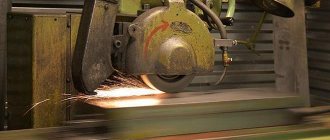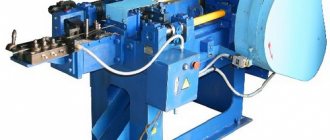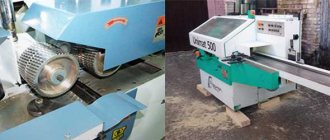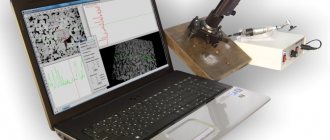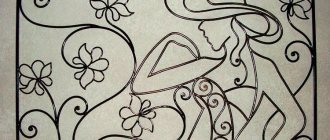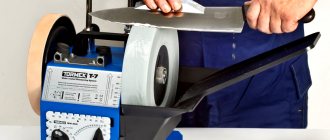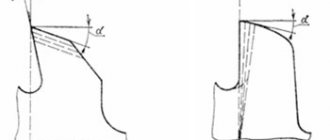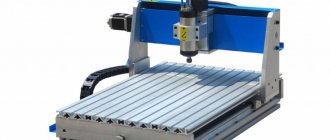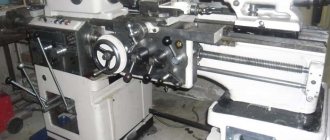Metal bending is a technology for changing the shape of a sheet metal blank.
The technological process of bending metal sheets is considered one of the most popular in the production of metal structures. In this way, clamps, ebbs, extensions, ridges, roofing elements, and parts for metal structures are manufactured. In order to bend such a hard material as metal, you need a sheet metal bending machine.
Design and scope of application of sheet metal bending machine
Machines for bending sheet metal are used in home workshops and factories. The devices have the same operating principle. Only the drive type changes. Bending machine design:
- The base that holds the desktop, movable mechanisms. This applies to models that are not fixed to workbenches.
- Pressing flywheels that hold the part during operation. Usually they are a metal plate.
- A wooden beam that acts as a cushion that acts as a support for the workpiece.
- Protractor for setting the desired angle.
- Stops limiting the sheet at the front and back.
Sheet benders are equipped with a special knife for cutting metal sheets. It is a separate tool that is mounted on the machine. The craftsman needs to make an effort to move it across the entire width of the workpiece. Sharp discs will cut thin sheet material to the specified size.
Sheet bending machines are used in various areas of industry:
Metal bending
The required result is obtained through metal deformation technology. When bending, the inner layer of the material is compressed and the outer one is stretched. In some ways, the bending operation is akin to straightening, the use of which eliminates defects - convexities and waviness.
Simple manual
Shaped metal parts cost a lot of money. Even more than corrugated sheeting or metal tiles, therefore it makes sense to make a simple machine for bending sheet metal, and with its help make as many corners, ebbs and other similar parts as you need, and exclusively to your own dimensions.
Sheet metal bending machine drawing
Bending machine - side view
Other model
If you're worried about appearance, you shouldn't be. On sale today there is sheet metal not only galvanized, but also painted. In all designs, the sheet is fixed tightly, so that when working it does not slide on the table, which means that the paint does not rub off or get scratched. It is also not damaged in places of bending. So the products will look quite decent. If you try, they will look even better than what they sell on the market.
Powerful sheet bending machine from brands
This sheet bending machine will require a flat surface (table), preferably metal, three corners with a shelf width of at least 45 mm, and a metal thickness of at least 3 mm. If you plan to bend long workpieces (more than a meter), it is advisable to take wider shelves and thicker metal. You can use brands, but this is for bending metal sheets of large thickness and length.
You will also need metal door hinges (two pieces), two large diameter screws (10-20 mm), wings on them, and a spring. You will also need a welding machine - weld the hinges and make holes (or a drill with a metal drill bit).
For a homemade sheet bender, a 70 mm brand was used - three pieces of 2.5 m each, two bolts of 20 mm in diameter, a small piece of metal 5 mm thick (for cutting jibs), a spring. Here's the procedure:
- Two brands are folded, and grooves are cut into them at both ends for hinges. The edges of the recesses are beveled at 45°. The third tee is cut in the same way, only the depth of the recess is made a little larger - this will be the clamping bar, so it should move freely.
Cutting notches for hinges - Weld the loops on both sides (weld on the front and back).
Boil the loops well - Two jibs on each side are welded to one of the brands (the one farthest from you, if you “open” them). They are needed so that you can install the clamping bar clamp bolt on them.
Such jibs - Weld the bolt nut to the jibs.
Weld the nut - Install the clamping bar (third cut tee), weld metal plates with a hole in the middle in the upper part. The diameter of the hole is slightly larger than the diameter of the bolt. Center the holes so that they are on the same vertical line with the welded nut. Weld.
Center, weld - Cut the spring so that it raises the pressure bar by 5-7 mm. Pass the bolt into the “ear” of the clamping bar, put on the spring, and tighten the nut. After installing the same spring on the other side, the clamping bar rises on its own when unscrewed.
Little things left - Weld two pieces of reinforcement to the screw head to serve as handles for tightening.
Weld pieces of reinforcement to the bolt head - Weld a handle to the movable (closest to you) brand. That's it, you can work.
Homemade sheet bender in progress
This option is very powerful - you can bend long workpieces and sheets of considerable thickness. Such scales are not always in demand, but they can always be reduced. The video suggests a similar design of a smaller size, but with a different fastening of the clamping bar. By the way, no one bothers you to also install a spring on the screw - it will be easier to raise the bar. What’s interesting about this design is that you can make beading on it, something that such devices usually cannot do.
From a corner with a different type of clamping bar
This model is welded from a thick-walled angle, the frame is made like an ordinary construction sawhorse, which is welded from the same angle. The handle is from a luggage trolley. The design of the screws is interesting - they are long, the handle is curved in the shape of the letter “L”. Convenient to unscrew/screw.
Small manual sheet bender for DIY production
This homemade sheet metal bending machine has many features:
- The corners are not arranged with shelves facing each other, but are directed in one direction. Because of this, attaching the loop is not the most convenient, but it can be done.
Peculiarities - On the bend of the far (fixed) corner, small stop plates for the pressure strip are welded on both sides.
- The screw nut is welded on the same strip (on both sides).
Clamping Bar
Now let's move on to the design of the clamping bar (pictured above). It is also made from a corner, but is laid on the machine with an upward bend. To ensure that the bar does not bend during operation, reinforcement is welded on - metal jumpers. Small metal platforms are welded at both ends of the strip, in which holes are drilled for bolts.
Another important point is that the edge that faces the bend is cut off to obtain a sharper bend angle.
The bar is set like this
The clamping bar is placed on the machine, and a spring is placed in the place where the nut is installed. The handle is installed in place. If it does not press the bar, it is raised above the surface due to the elastic force of the spring. In this position, the workpiece is tucked under it, positioned, and pressed.
Place a spring under the hole, then a bolt
A good option for home use. It will not be possible to bend thick metal, but tin and galvanized steel can be bent without difficulty.
Types and design of bending machines
Bending of sheet metal is carried out using specialized equipment - sheet bending machines. According to the operating principle, metal bending machines can be divided into several types:
Universal bending machine
Universal. When this machine operates, the sheet is placed in a fixed matrix and, with the assistance of a punch, it is given the required shape. Punches are made in several designs, which differ from each other in shape and size, for example, in angle. As a rule, a groove in the shape of an angle is made on the matrix.
Universal presses are easily reconfigurable and can solve many technological problems.
Turning. This machine consists of a traverse, as the bending beam is called, a bending beam and a back stop. A clamping beam is necessary to secure the sheet of metal to the frame. The bending of the sheet is carried out by a bending beam. In fact, it is the main working element of this machine.
Rotary bending machine
Rotary bending machine
Rotary. The design of such equipment may include several shafts (rolls). They rotate around their axis. In addition, the work rolls can move in a vertical plane. A sheet of metal is placed in the space between the shafts and by moving them vertically the future bending radius is adjusted. After the sheet passes between the rotating shafts, it receives the required shape.
A metal bending machine can be powered by human muscle power, hydraulic, pneumatic, electric (electromechanical) or mechanical drive.
Folding machine
Folding machine
To work with metal of small thickness, folding or folding machines are used. They are widely used when working with roofing sheets, creating ventilation ducts, etc.
Prices of sheet bending machines and delivery terms
Choosing and buying a sheet bending machine in Moscow is not so easy, especially for a person who has little idea of how the mechanism of this device works. Most often, the buyer looks for information in thematic catalogs or the press, or simply types in an Internet search: “buy a sheet bending machine,” for which he receives a very impressive list of offers in the search results. Navigating the sea of information on sheet metal bending mechanisms and comparing different designs, models and prices of sheet metal bending machines is not easy even for specialists.
Therefore, in order to buy a high-quality sheet bending machine, you should seek help from consultants who have proven themselves in the industrial market. We will answer all your questions and give advice on the equipment you are interested in and its cost at a time convenient for you. Buying from us is profitable and reliable; our specialists will draw your attention to the nuances that are usually lost amid the variety of information on sheet metal bending machines. By calling us right now, you can not only save time searching for a suitable option, but also buy a sheet bending machine at an attractive price!
offers to buy a bending machine for sheet metal at low prices with delivery throughout the Russian Federation, as well as Belarus and Kazakhstan. We cooperate with the largest transport companies in the Russian Federation, but at the same time we give our clients the opportunity to independently choose a transport company, at their request, in order to receive a sheet bending machine in good condition.
Types of bending machines
To get a complete picture of how a sheet bending machine works, you need to understand how it works. This equipment includes components such as a table on which workpieces are placed. The workpiece will move along its surface in a given direction. In addition, a cutter can be installed on the table, cutting off the finished parts from the sheet of source material. A roller knife or saber guillotine can be used as a cutter.
Bending machine
The bending machines include a protractor. It is used to set the angle at which the sheet should be bent. In addition to this unit, limiters that regulate the maximum height of the resulting product play an important role. The working bending length and maximum metal thickness for each type of machine are strictly individual.
In practice, the following types of bending machines are used.
Manual metal bending equipment
Manual equipment is small in size and can be easily transported from one place to another. It is used in single production. Manual machines are used to produce parts made of different materials, for example, aluminum, copper, galvanized steel. Operating such a machine does not require any special training.
Electromechanical equipment for metal bending
Mechanical equipment uses the energy of a flywheel in its operation, which is spun specifically for this purpose. Machines with an electromechanical drive operate through a drive station, which includes an electric motor, gearbox, belts or chains. Hydraulic units operate from energy received from a hydraulic cylinder.
Hydraulic sheet bending machines
By the way, for gentle bending of sheets, especially those coated, sheet benders using compressed air are used. There are also devices such as electromagnetic ones. They are quite often used in the manufacture of boxes and boxes. The working tools in such equipment are powerful electromagnets, under the influence of which the sheet bends.
A separate class of bending equipment is portable (mobile); as a rule, they are used directly in the workplace, for example, on a construction site.
Advantages and disadvantages of bending machines
Like any bending equipment, it has a number of advantages. These include the strength of the resulting finished parts. The use of bending machines allows you to form parts without the use of welding and cutting. After the bending operation is completed, the likelihood of corrosion phenomena occurring at the site where it is performed is reduced.
Calculation of bending force allows you to create a durable product
The use of bending machines makes it possible to create integral structures, and as part of such a product it is possible to obtain versatile bends and angles. But you also need to understand that bending equipment is quite expensive. Sheet bending operations are highly labor-intensive, especially if this work is performed on equipment designed for manual work. But the listed shortcomings are more than compensated by the quality of the resulting products.
Operating principle of various sheet metal bending machines
The technological equipment used in modern production for the creation of metal structures makes it possible to obtain finished parts with different dimensions and shapes from sheet material.
Roll bending
Manual sheet benders
These designs have a number of features, in particular, they have restrictions on the depth of the workpiece, the maximum thickness of the metal, its width, or more precisely the bending length. The thinner the metal, the longer the bending length. Most often, they are used for bending thin sheet metal.
Bending with a manual bender
The work of manual installation is constructed as follows: The sheet is pressed against the work table by the upper beam. The required bending angle is obtained by lifting the lower, rotating beam. When using this machine, it is necessary to keep in mind that the thickness of the sheet that can be processed should not exceed 2 mm.
Manual sheet benders are lightweight, and this allows them to be used both in stationary conditions and directly at the workplace, for example, on a construction site.
Hydraulic sheet benders
These machines use liquid as an energy source. The pump, built into the system, creates excess pressure, under the influence of which the plunger moves the movable transverse beam. The sheet to be processed is pressed against the work table, and the movement of the cross beam performs straightening and bending of the sheet.
Sheet benders of this class are used to process workpieces along the entire length of the work table; in addition, they are used to deep draw metal. The hydraulic cylinders feature positioning accuracy and high operating efficiency. Their use allows you to control the amount of movement, speed and movement of parts of the hydraulic system.
Hydraulic sheet bending machine
Hydraulically driven machines are used for the production of additional components, air ducts, and roofing parts. This equipment is used to make advertising structures and perform external and internal finishing of buildings and structures. The use of hydraulic equipment makes it possible to process sheets with greater thickness, for example, up to 4 - 8 mm. Of course, this value depends on the brand of material being processed.
Electromechanical sheet benders
The design of this equipment consists of a frame and a rotating beam for bending the sheet. In addition to the rotary beam, a beam assembled from profile sentiments is installed on the machine, which presses the sheet. For operator safety, this type of machine has pedal control.
Electromechanical sheet benders
This type of sheet bending machine allows you to bend long lengths of metal. They are used for processing various materials, including galvanized steel and cold-rolled steel 2.5 mm thick.
Machines of this type are used in the production of sills, window sills, and structures for ventilation systems.
Types of sheet metal bending machines and their areas of application
Structurally, a bending machine used for processing sheet metals is a frame with a work table on which a support stand and two beams are located - a pressing and a bending one. The worker places the sheet metal on this table, then fixes it with a clamping beam, after which he bends the sheet metal workpiece to the required angle using the turning beam of the device.
A sheet bending machine can be purchased with different types of drive, depending on the intended purpose:
- Mechanical – manual drive;
- Electromagnetic - manual with magnetic clamp;
- Electromechanical – drive with an electric motor;
- Hydraulic – drive with a system of hydraulic cylinders.
The most common is manual sheet bending. Its work is carried out through muscular effort. In this case, the thickness of the processed sheet usually does not exceed 2.5 mm. Using this machine, you can produce a wide range of industrial products, and the price of the sheet bender will be very attractive even for the most economical buyer, so even a novice entrepreneur can buy such a device.
The electromechanical bending mechanism has its advantages and disadvantages. Its design and scope of application do not differ from a manual type device, but its main advantage is high performance. The manufacturing process is fully automated and operates under automatic control. The negative side of this mechanism will be the increased noise level during operation of the device. And also the cost of the machine - the minimum price of such a sheet bender is about 100 thousand rubles. It will be very difficult for individual entrepreneurs and even small organizations to buy such a sheet bending machine.
A hydraulic bending machine for sheet metal is fundamentally different from its electromechanical and manual counterpart. Its operation is carried out using fluid and hydraulic cylinders. Both an electromechanical bending device and a hydraulic device can perform a large number of operations, bending thick sheet iron and rolled metal (more than 2.5 mm), but the high price of a sheet bending machine of this type, dimensions and weight allow only large industrial companies to buy such equipment.
Bending devices make it possible to process sheet metal and produce a huge range of industrial products: drainage systems, facade cassettes for building decoration, various advertising structures, as well as many other types of metal products. That is why you need to choose a bending machine wisely in order to buy a high-quality sheet bender at a low price.
Metal bending and its main methods
Sheet bending
It should be understood that metal bending operations are not limited to working with sheet metal. When creating metal structures for various purposes, there is a need to use bent pipes or profiles.
Radius sheet bending
Radial bending of sheet metal is performed using the equipment described above. When performing it, it is important to choose the correct linear size of the workpiece. The designer must remember that the length of the workpiece should be slightly longer than the length of the finished part. This is due to the specifics of the bending operation. The fact is that when the position of one part of the sheet changes relative to another, the inner layers of the metal are compressed, and the outer ones are stretched. That is, before performing radius bending of metal, it is necessary to carefully calculate the geometric parameters of the workpiece.
To calculate the bending radius, it is enough to use tabular data that can be found in almost any engineering reference book.
Main parameters influencing the choice
Before buying a sheet metal bending machine, you need to pay attention to the following characteristics:
- The greatest thickness
of sheet metal that can be processed on sheet metal bending equipment; - The maximum length
that the intended metal sheet to be processed has; - Price of the sheet bending machine, dimensions and weight
of the unit; - What additional equipment
is included in the package (this can significantly affect the price of the sheet bending machine); - What is the sheet feeding depth
, does it make sense to buy equipment with a limitation of this parameter, or is it worth opting for the pass-through option; - The presence of a cutting knife
and various additional settings and adjustments (this parameter may also affect the final price of the sheet bender).
Advantages of metal bending on CNC machines
More and more, the use of computer-controlled equipment is becoming the norm rather than the exception. Such machines can be seen in almost any production, regardless of its scale. The use of specialized software allows not only to increase the processing speed of parts, but also leads to noticeable savings in metal and increased accuracy of workpiece processing.
The work of processing workpieces on bending machines under CNC control is as follows:
The use of control systems allows you to achieve certain advantages over other metal processing methods:
In addition to the mentioned parameters, it is impossible not to mention the fact that the work on manufacturing products can be carried out 7/24 without the involvement of additional human resources.
Metal bending stages of the technological process
The metal bending process consists of several steps:
Bending metal in a bending die
After receiving it, it is necessary to perform control and measurement operations. This work is performed either by a shift foreman or an employee of the technical control department. To perform this operation, you must use a certified measuring instrument - a ruler, tape measure, protractor, etc.
If any defects are identified, it is necessary to make changes either to the equipment settings or to the text of the control program.
Only after passing technical control can the part be allowed for further use. Otherwise, substandard products must be sent either for rework or for disposal.
Metal bending and post-processing
In fact, bending operations are of an intermediate nature in the manufacture of certain components, for example, elements of metal stairs. That is, after bending, the resulting parts are sent to assembly production, where they are installed in the place specified in the working documentation for the product.
Assembly production
If the product will not be used as part of other structures, then a protective corrosion-resistant coating is applied to its surface. This can be a primer like GF 21, or powder paint. It all depends on the purpose and operating conditions of the finished product.
Why do you need a homemade sheet bender?
Bending sheet metal with your own hands is a completely feasible operation that can be performed at home. But many home craftsmen are stopped by the rather high price of sheet metal bending machines. For the needs of small-scale production or for work around the house, there is no need to install complex machines with hydraulic wires, but a manual machine will suffice.
In order to manufacture a machine of this kind, it is necessary to have at least draft documentation. It can always be found on the Internet, where you can either simply download or buy it. But it is best to study the operation of a working manual machine and implement the acquired knowledge in metal.
Homemade sheet bender
In fact, to build such a machine, you will need a certain amount of rolled metal, sheet material, a welding machine and metalworking tools.
Types of sheet benders
There are three types of sheet metal bending machines:
- Simple manual ones, in which metal bending occurs when force is applied in a certain place. These units make it possible to bend sheet material in a straight line at any angle - from a few degrees to almost 360°.
For bending sheet metal - Hydraulic machines in which sheet metal is bent to the shape of a matrix using impact. The matrix can be straight or curved. This equipment is professional, used in medium and high-power enterprises.
- Roller or roller bending machines. In them, the sheet of metal is not bent in a straight line but is rounded. Using this equipment you can make pipes or other similar products yourself.
To obtain radial bending of a metal sheet
All these devices are classified as sheet bending machines. The easiest way to make one with your own hands is the unit of the first group, a little more difficult - the third (rollers for sheet metal). So we’ll talk about them - from how to make a sheet bending machine with your own hands.
Machine base
To manufacture the frame, you will need a certain amount of profiled metal. This can be a channel or an I-beam.
Bed - base for the machine
When assembling it, you must remember that the structure must be rigid. The quality of metal processing depends on this parameter.
Roller knife
To cut the resulting part, you can use several types of knives, for example, saber or roller. Most often they are used to work with thin sheet material. When assembling a homemade sheet bender, it is advisable to purchase a roller blade from a company that supplies such equipment.
Roller knife of a homemade sheet bender
The thing is that for the manufacture of roller shears, as well as others, tool steels are used. To obtain working parts, it is necessary to use heat treatment, and this is unlikely to be done at home.
Profile benders
This section presents machines that allow you to shape profile pipes, round pipes and rolled products, strips, channels, square and rectangular profiles, etc. radius shape, performing circular bending,
performed with different internal bending radii in one or several planes with the spiral winding option.
The difference between this group of equipment and conventional pipe benders is that they are a bending mechanism, the bending device of which consists of rolling and gradually changing the bending radius of the installed workpiece. Rolling (or rolling) of the workpiece is carried out between 3 rollers installed in a horizontal or vertical plane, a pair of which are drive rollers (with manual or electromechanical drive), and one is a pressure roller or central one (manual, hydraulic, electromechanical drive is possible) , it then ensures that the required radius is obtained by moving along the axis in a perpendicular direction, increasing the pressing force on the metal profile, forcing it to take a more curved radius. This arrangement of the rollers of profile bending machines does not allow the machines to produce sharply curved workpieces; here, as a rule, the range of internal bending radii starts from 5D of the profile that is installed on the bending machine, the maximum value can be limited only by the structural dimensions of the profile bender.
A machine for bending profile pipes is necessary in almost any field of activity and is indispensable when working with various types of metal structures. Products produced using profile bending/pipe bending machines:
- arched structures (vaults, canopies, canopies, greenhouses, stained glass windows);
- frames for furniture products, street benches;
- children's and sports grounds;
- various types of fences (atriums, spiral staircases);
- building metal structures, roofs and openings.
When choosing a roll forming machine,
It should be understood that there are several main types of equipment such as profile bending machines, the design of which and the specifics of operation must fully comply with the parameters of your product, such as:
- pipe diameter or profile section,
- wall thickness,
- internal radius and bending
.
Therefore, no matter what model of machine for bending a metal product we are talking about, you need to understand what material (profile, pipe, rolled product, channel, strip, etc.) you have to work with and what bending parameters you want to achieve in the end.
